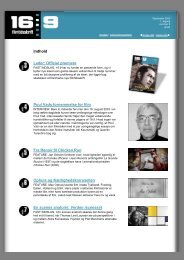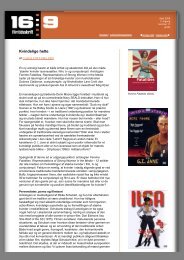You also want an ePaper? Increase the reach of your titles
YUMPU automatically turns print PDFs into web optimized ePapers that Google loves.
Forside Indhold Arkiv Abonnement Profil Links Kontakt English<br />
<strong>16</strong>:9 in English: The Big Swede: The Tribulations of a<br />
Dane in 1920s Hollywood<br />
By LAURA PETERSEN BALOGH<br />
The story of Karl Dane is a Cinderella story gone horribly wrong.<br />
A simple working class dreamer from Copenhagen, he came to<br />
America and achieved fame and fortune in 1920s Hollywood.<br />
But he became an outsider almost overnight and ended up<br />
operating a hot dog stand just outside of the studio, where he<br />
had once been a star. This first-time ever analysis will take a<br />
look at this neglected star and his Nordic screen<br />
characterizations. Was Dane truly a talented artist or was he<br />
simply an empty cipher, guilty of perpetuating negative<br />
Scandinavian stereotypes that existed in this era?<br />
The name of Karl Dane, if it is remembered at all, brings to mind<br />
Hollywood scandal and tragedy. A popular comic star and character<br />
actor, Dane’s Scandinavian accent was judged unsuitable for sound<br />
films, and he committed suicide by gunshot in 1934.<br />
In the seven decades since Karl’s death, no one has ever attempted a<br />
serious study of his screen characterizations. Known as “The Big<br />
Swede” or “The Great Dane” on the MGM studio lot and by American<br />
film audiences who could not really differentiate between the Nordic<br />
countries, he was best known for his tall (6’3 ½”), gawky, rubber-faced<br />
look, and his lumbering, lovable, <strong>som</strong>ewhat soft-headed portrayals (fig.<br />
2).<br />
The Fact and the Legend<br />
According to Hollywood legend, Karl Dane was a simple studio<br />
carpenter when director King Vidor discovered him, and gave him a<br />
starring role in 1925’s smash war film, The Big Parade. However, this<br />
was complete fiction. The way to fame was a long and arduous one for<br />
Karl Dane, who was nearly 40 when he achieved true stardom.<br />
The son of a glovemaker, Karl was born Rasmus Karl Therkelsen<br />
Gottlieb on October 12, 1886, in Copenhagen. After marrying and<br />
fathering two children, he immigrated to the United States in 19<strong>16</strong>, due<br />
to high unemployment caused by the war.<br />
Settling in Brooklyn, he supplemented his factory work by taking jobs<br />
as an extra and stuntman. His imposing and unconventional looks got<br />
him noticed, and he was cast in the first propaganda picture in<br />
America, My Four Years in Germany. In this film, he was cast as the<br />
giant German Chancellor von Bethmann-Hollweg, a role he would<br />
reprise in two other films. Germany, which still survives today, reveals<br />
a very different Karl Dane than in later films: elegant, aristocratic, and<br />
urbane, he brings to mind a young Christopher Lee.<br />
Karl immediately moved on to serials, working with director Joseph A.<br />
Golden and motorcycle daredevil Charles Hutchison in The Wolves of<br />
Kultur (1918), and The Whirlwind (1919), among others. In Kultur, Karl<br />
played the main henchman, Carter, an unusually brutal, sadistic,<br />
woman-beating villain. Karl’s simple, naturalistic portrayal of the<br />
character made him all the more frightening.<br />
Karl quit films for awhile after becoming discouraged with the quality of<br />
his roles, and became a chicken farmer in southern California. But<br />
Fig. 2: Karl in The Big Parade.
















